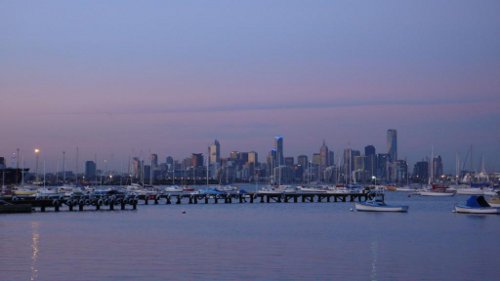Two months ago, I ended up in Australia (or, to be precise: Melbourne). After a scientific career in heavy ion physics at the Garching Maier-Leibnitz Laboratory and 30 years of work in various IT functions, I started the time-off phase of my old-age part-time in March 2012. Late in 2011, my wife had received an interesting job offer for Melbourne. After an intense discussion – where the fact that our daughter lives in New Zealand played a considerable role – we decided (so far on a tentative basis) to emigrate to Australia.
Here is some information up front: by now, we managed to do the most important tasks (rent a house, gas, electricity, water, cable TV, telephone, internet…). In a few days, the container will arrive with all our stuff. Then we can start furnishing our house.
Let me start describing some of my(totally subjective) impressions of Australia.
The Weather
Of course, the first thing you notice on a trip to the Southern Hemisphere is the weather: the astronomical winter on the southern hemisphere lasts from June, 21st to September, 23rd. Since Australia is situated between 10 and 44 degrees latitude south-east, this does not say a lot about the entire continent, does it? As far as Melbourne is concerned, we can say: in the daytime, the temperatures are between 17 and 11 degrees Celsius (dependent on how long the sun shines). At night, you might well get 6 degrees Celsius. There is comparatively little rain, but when it rains, it really rains.
Sunrise is currently around 7:30, sun-down at 17:20. Fewer than half of the trees have shed their leaves, some plants already start blossoming – so it does not really look like winter at all.
There is a famous proverb: ‘If you don’t like Melbourne’s weather, wait five minutes and it will change’!
That is totally correct. Here is what it means: as far as clothes are concerned, you have to be prepared for everything at all times. In extreme cases, you can experience all the four seasons on a single day.
In short: winter is roughly what you would see in Germany late in April or early in May, but dryer.
Due to the short period of cold weather, central heating is almost unknown. In our house, the only heating is air conditioning in the living room. It can be switched to heat pump. Since our house, like almost all houses, is made of Rigips, wood and corrugated iron, it gets rather cold in the morning.
Apparently, the Melbournians try to ignore the winter. For me, this seems the only explanation why girls going to school wear mini-skirts and boys shorts. Cool young people like to wear t-shirts – even in inclement weather.
I wonder if such a thing as season-jetlag exists. Some way or other, I miss the summer I was cheated out of (let us wait and see how I will feel about it five months from now)….
Here is a picture of Downtown Melbourne seen from Williamstown Marina
Pelicans near our house
The city of Melbourne
In many sectors of the city, Melbourne seems very European (no surprise, after all, there were many immigrants from Europe – according to a well-known joke, Melbourne is the second biggest Greek city after Athens). That is also the reason why they have suburbs like Altona, Brunswick, Coburg and Heidelberg.
Melbourne can boast a huge number of excellent museums and art galleries (for example the National Gallery of Victoria).
It is truly enjoyable to walk through the city centre and look at the thousands of shops – especially in the beautiful historical pedestrians’ arcades. Now is a time when you can buy high-quality clothes at reasonable prices. As a general rule, however, you will always want to be careful with prices (I will tell you more about it in another article).
Comparison with Sydney: Melbourne cannot quite compete with Sydney’s spectacular location. The Sydney skyline with the opera house and the Harbour Bridge is unique in the world. And the beach not far from our house, too, is not quite as wonderful as Bondi Beach. Regardless, Melbourne has some charm of its own, in particular through its lively downtown, which seems European.
Willamstown Beach
We live in Williamstown, a suburb around 13 kilometres from the city centre. Here is where the first harbour for sea ships used to be at the Port Phillip Bay. The place is older than Melbourne. We do not yet have a car of our own. That is why this place is ideal for us: if you take the metro, you will reach the city centre (Central Business District – CBD) in 25 minutes. We have a good infra-structure and all necessary shops (and the beach) are within walking distance. Near the beach, you will find the Jawbone Marine Sanctuary. With a multitude of oceanic birds – mostly pelican, cormorant, booby and ibis.
Eating out and food
Melbourne (and most of the rest of Australia, as well) is very prosperous – and you will notice it instantly from what things cost: if you want a good dinner for two at CBD, you will have to pay 500 $[1]. Two weeks ago, I went there for a hamburger and a glass of beer and paid 31 $ (incidentally, the beer tastes rather well – they have a number of small, creative breweries).
We often eat Vietnamese or Chinese – where you mostly get excellent quality for reasonable prices.
Locally produced vegetables, meat and fish are often considerably less expensive than in Munich. For me, it came as a surprise to find that there is a huge variety of locally produced, high-quality meat specialties, for instance Salami (you can even get high-quality Bavarian collared pork).
Wine:
In Australia, they grow excellent wine, but, as everywhere, quality has its price. The first time we went into a Vinothek, I asked the salesperson to offer me a bottled wine under 30$; well, that is what he brought – but he looked at me like I had ordered canned wine.
If you go and drink directly at the vintners’, you will also find excellent wines. But even there, you will hardly get a bottle for less than 25$.
The People
Mostly, the people are friendly and helpful. Unfortunately, this is not always true for young persons: the first experiences my wife made with young Australian co-workers were not exclusively positive. Many young employees are egoistical, pampered and basically have not enjoyed a good upbringing. Moreover, the training of Australian IT professionals mostly cannot hold a torch to that in other countries (for instance India). Demanding technological problems are almost always tackled by Indians or Asians.
The people are disarmingly honest if something does not work as it should (and there are quite a few things that don’t). Here is an example: on weekends, metro-trains often change their routes. At those times, friendly metro-link employees will walk all the way through the trains and apologize to the passengers, asking them to listen to the announcements. Unfortunately, they cannot do anything about it, but the train is doing a different route this time ”no worries mate“…
As far as language goes, I still have a few problems trying to understand some of the people around this place. To be sure, I knew from earlier vacations in Australia and New Zealand that the people here speak English in a way that sounds like they have a hot potato between their teeth. The problems start when I communicate with immigrants from Asia (practically everything physically demanding is done by Asian immigrants). Those are the times when I can only guess what the speaker means (incidentally, this is not true for young Chinese. Their English is excellent).
So this was the first of my highlights – more to follow.
No Worries
JRO
(Translated by EG)


